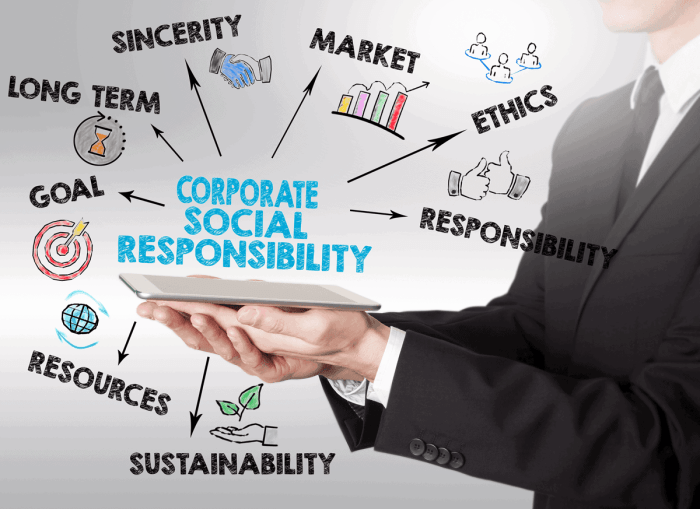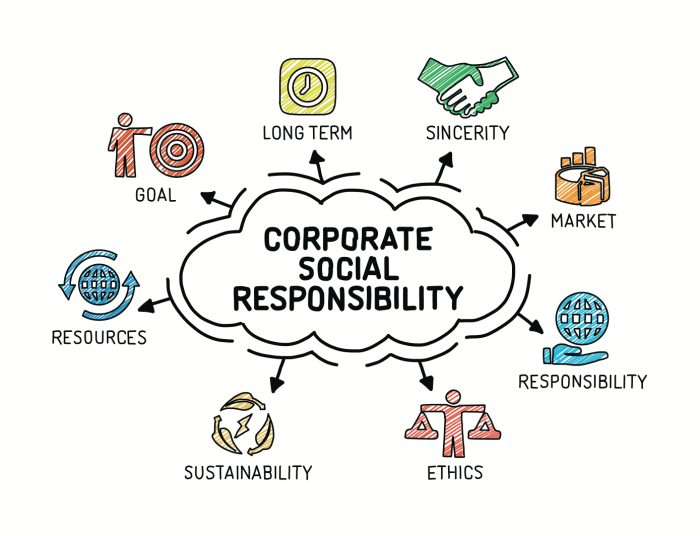Corporate social responsibility is not just a buzzword; it’s a game-changer in the business world. Imagine companies not only focusing on profits but also on giving back to society and the environment. Get ready to dive into a world where business meets social impact in unexpected ways.
From defining CSR to exploring its impact on environmental sustainability and community engagement, this topic is a rollercoaster of insights and inspiration.
Defining Corporate Social Responsibility

Corporate Social Responsibility (CSR) refers to a company’s commitment to operate in an economically, socially, and environmentally sustainable manner. It involves taking responsibility for the impact of its activities on various stakeholders, including employees, customers, communities, and the environment.
Examples of Strong CSR Initiatives
- Patagonia: Known for its environmental initiatives such as reducing its carbon footprint and using sustainable materials in its products.
- Microsoft: Through its philanthropic arm, Microsoft Philanthropies, the company has donated billions of dollars in cash grants and software to nonprofits worldwide.
- Starbucks: Implements ethical sourcing practices, fair trade policies, and community support programs in coffee-growing regions.
Benefits of Incorporating CSR
- Enhanced reputation: Companies with strong CSR initiatives are viewed more favorably by customers, employees, and investors.
- Increased employee engagement: CSR can boost employee morale and motivation by giving them a sense of purpose and contributing to a positive work culture.
- Risk management: Addressing social and environmental issues proactively can help mitigate risks and avoid potential crises that may arise from negative impacts of business operations.
Implementing CSR Programs
Implementing a CSR program within a company involves several key steps to ensure its success. It is essential to develop a strategic plan that aligns with the company’s values and goals while also addressing the needs of the community and the environment.
Developing a CSR Strategy
- Conduct a thorough assessment of the company’s current impact on society and the environment.
- Identify key areas where the company can make a positive difference through its CSR initiatives.
- Set specific, measurable, achievable, relevant, and time-bound (SMART) goals for the CSR program.
- Allocate resources and designate a team responsible for implementing and monitoring the CSR initiatives.
Communicating CSR Initiatives
- Engage with internal stakeholders, such as employees, to build awareness and support for the CSR programs.
- Utilize various communication channels, such as company newsletters, intranet, and meetings, to keep employees informed about CSR initiatives.
- Externally, communicate CSR efforts through press releases, social media, and corporate sustainability reports to showcase the company’s commitment to social responsibility.
- Partner with NGOs, community organizations, and other stakeholders to amplify the impact of CSR programs and reach a broader audience.
Successful CSR Programs
- Patagonia: Known for its environmental activism, Patagonia’s CSR programs focus on sustainability, fair labor practices, and environmental conservation.
- TOMS Shoes: Through its “One for One” model, TOMS donates a pair of shoes to a child in need for every pair sold, making a tangible impact on communities worldwide.
- Unilever: Unilever’s Sustainable Living Plan integrates sustainability into its business strategy, aiming to improve the health and well-being of a billion people while reducing its environmental footprint.
Environmental Sustainability: Corporate Social Responsibility

In today’s world, environmental sustainability has become a critical focus for organizations looking to reduce their impact on the planet and promote eco-friendly practices. Corporate Social Responsibility (CSR) plays a crucial role in driving these initiatives within companies.
Companies can reduce their carbon footprint and promote eco-friendly practices by implementing sustainable strategies such as reducing energy consumption, minimizing waste production, using renewable resources, and investing in green technologies. These actions not only benefit the environment but also contribute to cost savings and enhance brand reputation.
Leading Companies in Environmental Sustainability
- Apple: Apple has committed to using 100% renewable energy for all its facilities and has made significant progress in reducing its carbon footprint.
- Patagonia: Patagonia is known for its strong environmental stance, using sustainable materials in its products and actively supporting environmental causes.
- IKEA: IKEA has implemented various sustainability initiatives, such as investing in solar energy, recycling programs, and promoting energy-efficient products.
Social Impact and Community Engagement
Corporate Social Responsibility (CSR) programs play a crucial role in creating a positive social impact on communities. By engaging with local stakeholders and addressing social issues, companies can make a difference beyond their business operations.
The Importance of Community Engagement in CSR Initiatives
Community engagement is essential for the success of CSR initiatives as it involves actively involving local residents, organizations, and leaders in decision-making processes. By understanding the needs and priorities of the community, companies can tailor their CSR programs to have a more significant impact.
Examples of Effective Community Engagement by Companies, Corporate social responsibility
- Company A partners with local schools to provide educational resources and scholarships for underprivileged students.
- Company B organizes volunteer programs for employees to support community clean-up initiatives and local charities.
- Company C collaborates with local small businesses to create economic opportunities and promote sustainable development in the community.





